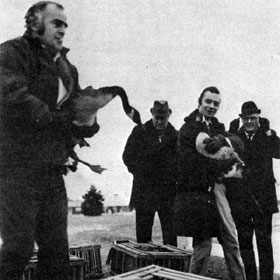10 Canadian Geese Join NAL Family
Early last Fall, John Barry and Rudy Dorner stood outside the Curia and watched a flock of geese fly south over NAL's 6,800-acre site. The annual exodus prompted them to speculate on the prospects of providing facilities and a habitat at NAL for geese to "winter over and hopefully to breed."
Several weeks later, Barry was in communication with a former colleague at the University of Michigan, Prof. Donald I. Meyer. The Ann Arbor physicist asked Barry's assistance in acquiring wild ducks to breed at NAL as a symbol of the academic community's support of the dedication of Robert R. Wilson, NAL's Director, in pursuing strict conservationist philosophies in developing the Laboratory.
"I suggested that perhaps a more significant gesture would be the presentation to NAL of Canadian Geese to be used for breeding, and we agreed that this would be a worthwhile effort," recalls Barry, of the Director's Office staff. Then, Barry began a lengthy, sometimes frustrating attempt to locate Canadian Geese, ready, willing and able to make NAL their home - temporarily, at least, if not permanently. Dorner, NAL's Site Manager who came to the Laboratory from Illinois Department of Conservation, helped in the search for new wild game.
It was thought that NAL provided a unique and appropriate environment for declining species of certain game. The presence of the Canadian geese, it was thought, would encourage flocks of other birds to "stop-over" as they migrated from the North to the South on their middle-west flyway.
Eventually, Barry was referred to State Rep. Bruce Waddell,who represents the 33rd District in Illinois' General Assembly. Waddell has been active for years in Izaak Walton League and is a member of Illinois' Giant Canada Goose Committee.
On December 30, Waddell brought to NAL 10 Giant Canada geese, which were accepted by Robert Hines, Farm Manager, and Barry, on behalf of NAL as a "loan" from the Izaak Walton League. Explained Waddell: "The Committee's aim is to provide breeding birds to co-operators who, in turn, agree to protect and to nurture the birds. Ultimately, we hope the plan is successful enough so that we can place the offspring of the geese back into their natural flyways."
The species planted at NAL is the "Canadensis Maxima." It is native to this area, and it is rare, as it was thought that the Maximas became extinct about 50 years ago. However, in 1960, an Illinois Natural History Survey expert identified some in a winter flock near Rochester, Minn. Since then, flocks have been observed at nearby Woodstock, IL. The birds at NAL came from the McGraw Wildlife Foundation's preserve, near Dundee. The Maximas grow to a larger size (average about 20 lbs.) than other species, which average nine pounds.
Five females and five males are in the NAL flock. The Canada goose averages 30 years in its life span. NAL's flock is now between two and four years of age. A large specimen of Maxima has a wingspread in excess of six feet.
The Giant Canada population in the U.S. and Canada has been estimated recently at about 50,000. Giant Canadas have personality quirks, too. They often fight for nesting sites. Sometimes the gander is goaded on by the female and a battle to death ensues. The geese copulate in water and are happiest in an "island" situation either created artificially or in a natual setting. This also has the advantage of protecting them from predators. They are vulnerable to dogs and foxes - even raccoons. After they have "paired off," the geese can be moved in pairs to new locations. The mating normally lasts a lifetime, unless the birds are placed in some abnormal circumstance.
At present, NAL's geese reside in the fire pond behind the Curia. Visitors are invited to view them, but are cautioned to keep a distance because of the birds' powerful wings. The flock may be moved to other sites at NAL after they have paired-up sometime this Spring. Geese have strong homing instincts and tend to return to the same area in which they were hatched to build their own nests. They migrate as far north as the Arctic Circle.
Explained Rep. Waddell: "There is a continuing need to put back into nature something that was taken out by man. It is a great satisfaction to work with a bird this size and to get to know its family characteristics."
Barry and Hines said they hoped that the new NAL family members would attract other geese. Perhaps, they note, the Izaak Walton League soon will provide prairie chickens. The chickens would join the two herds of buffalo, Mallard ducks, deer and other animals and birds that will be "invited" to establish homes in the ex-urban environment of the world's largest scientific instrument for pure research.





